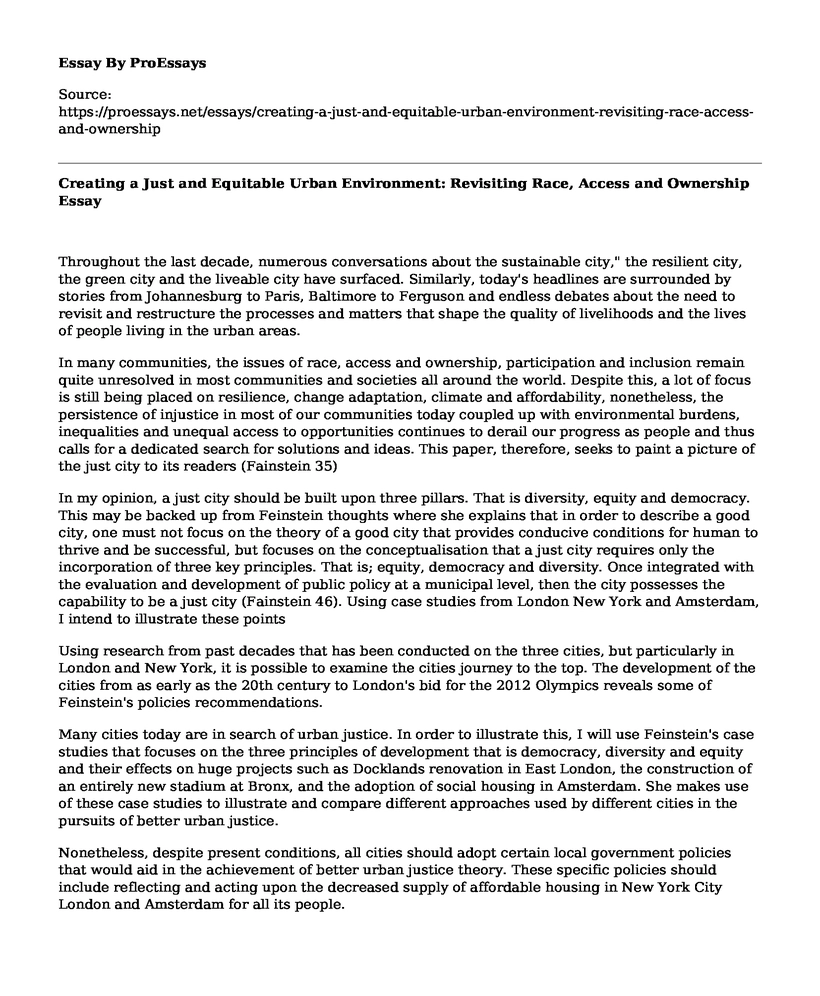Throughout the last decade, numerous conversations about the sustainable city," the resilient city, the green city and the liveable city have surfaced. Similarly, today's headlines are surrounded by stories from Johannesburg to Paris, Baltimore to Ferguson and endless debates about the need to revisit and restructure the processes and matters that shape the quality of livelihoods and the lives of people living in the urban areas.
In many communities, the issues of race, access and ownership, participation and inclusion remain quite unresolved in most communities and societies all around the world. Despite this, a lot of focus is still being placed on resilience, change adaptation, climate and affordability, nonetheless, the persistence of injustice in most of our communities today coupled up with environmental burdens, inequalities and unequal access to opportunities continues to derail our progress as people and thus calls for a dedicated search for solutions and ideas. This paper, therefore, seeks to paint a picture of the just city to its readers (Fainstein 35)
In my opinion, a just city should be built upon three pillars. That is diversity, equity and democracy. This may be backed up from Feinstein thoughts where she explains that in order to describe a good city, one must not focus on the theory of a good city that provides conducive conditions for human to thrive and be successful, but focuses on the conceptualisation that a just city requires only the incorporation of three key principles. That is; equity, democracy and diversity. Once integrated with the evaluation and development of public policy at a municipal level, then the city possesses the capability to be a just city (Fainstein 46). Using case studies from London New York and Amsterdam, I intend to illustrate these points
Using research from past decades that has been conducted on the three cities, but particularly in London and New York, it is possible to examine the cities journey to the top. The development of the cities from as early as the 20th century to London's bid for the 2012 Olympics reveals some of Feinstein's policies recommendations.
Many cities today are in search of urban justice. In order to illustrate this, I will use Feinstein's case studies that focuses on the three principles of development that is democracy, diversity and equity and their effects on huge projects such as Docklands renovation in East London, the construction of an entirely new stadium at Bronx, and the adoption of social housing in Amsterdam. She makes use of these case studies to illustrate and compare different approaches used by different cities in the pursuits of better urban justice.
Nonetheless, despite present conditions, all cities should adopt certain local government policies that would aid in the achievement of better urban justice theory. These specific policies should include reflecting and acting upon the decreased supply of affordable housing in New York City London and Amsterdam for all its people.
As such, to increase equity, it is of great importance that housing units be developed in a manner that they will be affordable even to the lowest earning citizen, and be subject to frequent renovations and repairs (Fainstein 50).
Nonetheless, it is important that these policies be reviewed before their implementation to ensure that it will meet the goals set out in the three main principles governing a just city. Therefore, if the goals of the developer's planner's local officials and the residents are all geared toward creating a just city, then it is mandatory that these policies be laid out systematically.
Feinstein (39) after reviewing the attention on the cities noted that they are a privileged context where citizens' rights, the market' cultural diversity and public policy come together to form new challenges for the retreat or development of social justice. Engrained in the social critical theory of tradition, her opinions about urban justice stems from the theoretical opinions of great philosophers such as Peter Marcuse, Martha Nussbaum and Michel Foucault (Fainstein 43).
Her main aim based on the theories and philosophies posed by each is to properly explain the theme of equality. She affirms that the equality of all people in regards to fundamental human rights, for example, the participation in decision making that shall eventually lead to the creation of any just and urban policies. As such, she emphasised the need to prioritise on policies that would secure a decent living for all people from low income families as well as the disadvantaged ones. She closes in on the gap that exists between her Marxist background and the emphasis posed on most of the highly disadvantages citizens by liberal theorists, by emphasising that priority should be given to the most disadvantaged ones.
Conclusion
In conclusion therefore and as seen from the essay above, to have a just city, it is important that policies be formed within a community by the leaders, developers and people at large in a manner that focuses among other things providing affordable housing to the people coming from low-income families. Additionally, this policy should be focused on the three main principles that are aimed at building a just society that is diversity, equity and democracy.
Work cited
Fainstein, Susan S. "Planning and the just city." Searching for the just city. Routledge, 2009. 39-59.
Cite this page
Creating a Just and Equitable Urban Environment: Revisiting Race, Access and Ownership. (2022, Dec 29). Retrieved from https://proessays.net/essays/creating-a-just-and-equitable-urban-environment-revisiting-race-access-and-ownership
If you are the original author of this essay and no longer wish to have it published on the ProEssays website, please click below to request its removal:
- Supreme Court Declines to Hear Telecom
- Illegal Immigrants Should Have the Same Rights as Everyone in America - Essay Sample
- Sociological Analysis of "Mean Girls" Essay
- Post-9/11 Legal Basis for Implementing Current Homeland Security Initiatives - Essay Sample
- Essay Sample on Crime Scene Vantage Point
- Essay Sample on Public Courtroom Trials: Cameras in the Courtroom & Impact
- Essay Example on Lesbian Rights and BDSM: Establishing Mental Condition for Justice







